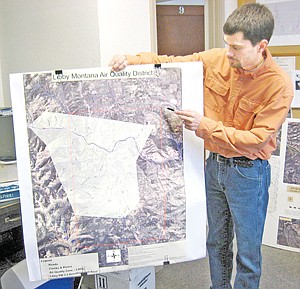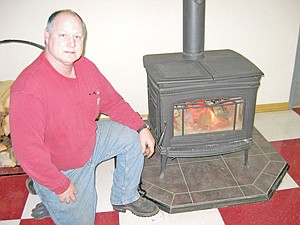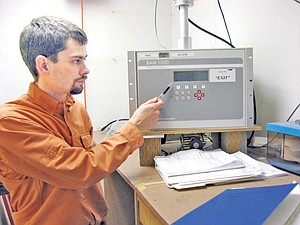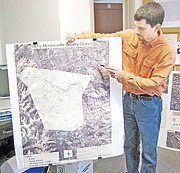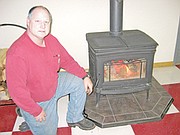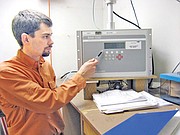Breathing easier: Stove Changeout Program was key to improved air
Air quality in Libby has steadily improved during the last five years as residents are reaping the benefits of a Wood Stove Changeout program initiated five years ago.
Statistics obtained by The Western News reveal the success of the program.
In fact, since 2000, the air within Libby’s Air Quality District, has steadily improved, despite an aberration in 2005, particulate matter saturating the air has increasingly lessened.
The reason, say Lincoln County Environment Health officials, is as clear as the improved air.
“Yes, I’d have to say the Woodstove Changeout Program played a role in that,” said County Environmental Technician Erik Leigh. “The numbers would indicate that.”
The release of the improved air-quality figures is welcome news to a community that already has a populous with breathing problems wrought by exposure to asbestos and with a higher than national average of mesothelioma cases.
Certainly, the emergence of greater-efficient stoves more than a decade ago may have initiated the trend, but the Woodstove Changeout Program in Libby from 2005 to 2007 saw as many as 1,188 of the 1,900 registered stoves (62 percent) in the Libby Air Quality District replaced, upgraded or rebuilt in favor of more efficient devices.
In fact, between the first and second years of the program that saw 260 low-income families change out their stoves for free — 2005 to 2006 — the air quality in Libby met the National Standard at 15 micro-grams per meter-cubed for the first time, and since, the particulate matter rate has continued to decline.
Nationally, the 15 micro-grams per meter-cubed figure takes into consideration auto and factory emissions, which, for the most part, are negligible here, with just 7 percent attributed to gasoline-powered autos. An even lesser amount — 4 percent — is attributed to diesels. These numbers are substantially higher in metropolitan areas.
Those numbers in 2007 when the program concluded were,13.05 micrograms per meter-cubed; 2008, 12.9; 10.62 in 2009, and in the long winter of 2010, the number rebounded somewhat, but was still far below the national requirement, at 11.40 micro-grams per meter cubed.
“The Changeout Program was huge,” said Kathi Hooper, director of the Environmental Health Department. “The most significant group — the low-income group — for them their wood stove is the sole heat source. Many of those stoves were old models. When those stoves were changed out for the more-efficient models, it made a big impact on air quality.”
The Libby Air Quality Area is massive, more than just Libby. In fact, the area includes about a district about 13 miles wide by 18 miles deep, or 234 miles, running to about Dorek Creek in the north to Swamp Creek in the south.
Multiple times daily air-quality samples are collected from the electronic monitoring device within the Lincoln County Annex. The device draws air from a pipe that protrudes the roof and sends that data to a recording tape that moves from reel-to-reel within the device. The particulate matter is diagnosed and air-quality updates are recorded.
This weekend, for example, the air quality in Libby was “Good” both Saturday and Sunday. Certainly, the less-frigid air temperatures mean families do not need to burn as much wood to warm their homes, but with nighttime low temperatures in the 20s, the air quality may not have been rated as high before the stove changeout.
“Oh, the stoves have made a difference, that’s for sure,” said Rick Gullingsrud, owner of Rick’s Rental and a salesman of the high-efficient stoves.
“I’ve live here all my life, and when I was a kid 45 years ago, I used to live right over that way,” Gullingsrud said pointing toward the front window of his business located at 31227 U.S. Highway 2.
“Back then, in January, the sky was black with wood smoke. These stoves are so much more efficient than even ones just years ago. Nowadays, these stoves can burn wood so efficiently that the smoke just looks like (water) vapor.”
Gullingsrud cautioned, too, that even modern stoves, if not operated properly, will emit larger amounts of emissions.
“If the wood you burn is not dry or you fill the thing up with wood and close it off right away, it probably won’t burn right,” Gullingsrud said. “You’ve got to let the stove, the fire, get hot enough to where it reaches ‘reburn’ and when it does that, it’ll burn correctly,” he said.
Gullingsrud, whose business is located on the west end of town, offers oil, gas, wood and pellet stoves. Among the brands he offers are Quadra-Fire, Pacific Energy, Country/Lennox, Vermont Castings, Jotul and Enviro.
In addition to the 260 stoves that were changed out for low-income families during Phase 1 of the program, 828 other stove changeouts were completed during the second phase of the plan. Also, 91 stoves were of the quality they could be rebuilt and brought to with the standards. Finally, nine wood stoves were surrendered and those families then went to propane, oil or electricity to meet their heating needs.
During the Phase 2 plan in which 828 wood stoves were 72 percent were replaced with a wood stove, insert or furnace. Homeowners also converted 16 percent to pellet stoves, 7 percent changed to propane, 3 percent changed to oil and 2 percent selected electricity.
Interestingly, the University of Montana conducted a study of indoor air quality before the stove changout and then again afterward. The study found that indoor air quality levels (PM2.5) improved approximately 72 percent with the newer stoves.
“So much of this has to do with burning the stove correctly,” Hooper, the Environmental Health Director said. “If people are burning it according to the manufacturer’s recommendations, at the right temperatures with seasoned, dry wood, it works so much more efficiently. And that helps everyone, especially in Libby where we have many people already with breathing problems.”


